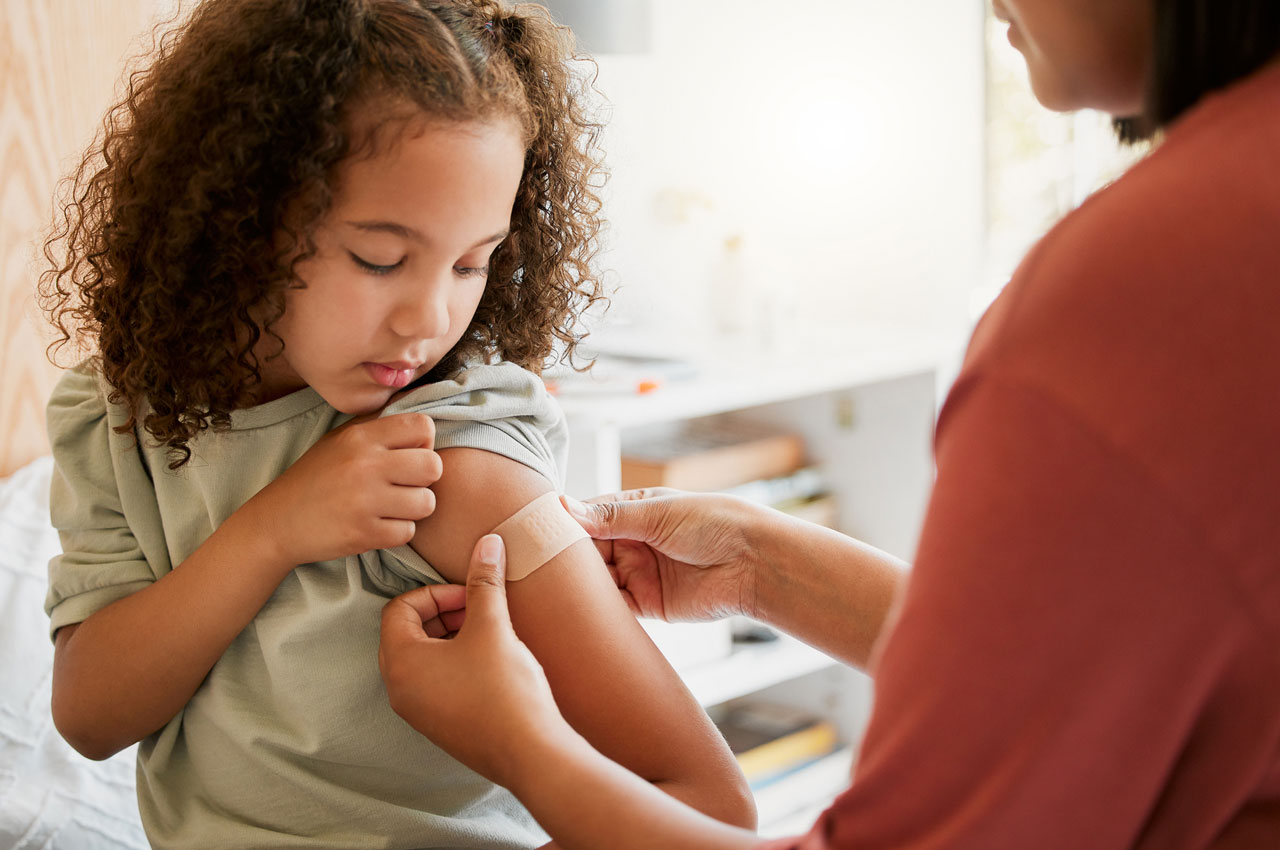What if Needle Pokes Were Less Scary?
We promise to do all we can while you’re in our care to increase comfort and minimize distress.
Immunizations and other needle pokes are an important and, for some, a frightening part of pediatric care. Fear of needles most commonly starts in childhood and can result in significant future health impacts. In fact, about 25% of adults have a fear of needles and 10% of the population avoids medical procedures due to needle fears.
As a parent, you are in a unique position to support your child feeling more comfortable and brave during needle pokes. We’re here to help with that.
Try Our Comfort Menu
We have a menu of choices to help patients of all ages feel more at ease during immunizations and medical procedures. Ask your medical assistant for more information.
Oral sucrose for infants
Numbing spray
ShotBlocker®
Buzzy® Bee
Sour lollipops
Bubbles
Pinwheels
Putty
The comfort menu is available at no cost to patients.

Comfort Methods for Infants
There are many ways to comfort infants during immunizations and medical procedures. Here are a few methods:
- Breastfeeding: Breastfeeding can provide comfort and security for infants, and the sweetness of the milk can help distract them from the pain. Start breastfeeding a few minutes before the procedure and continue during and after.
- Oral Sucrose: Oral sucrose, or sugar water, can help decrease pain and distress during medical procedures. A small amount of the solution is placed on the infant’s tongue.
- Comfort Positioning: Comfort positioning is a variety of secure, hugging holds that can help reduce stress in infants. Ask your medical assistant for help getting the infant into a comfortable position.
Some infants may prefer one method over another. Try different soothing techniques, and you will eventually find what helps your infant feel the most comfortable.
Comfort Methods for Children and Teens
Feel Strategies
It’s important to have a relaxed body when getting shots to reduce pain and discomfort. When you’re tense, your muscles are tight, which can make it more difficult for the needle to go in. It can also make the pain more intense.
Try these techniques and tools to feel more relaxed and brave during injections:
- Pinwheel Breathing: Breathe in slowly and deeply, and then exhale slowly while blowing on a pinwheel.
- Slow, Smooth, Steady Breathing: Breathe in and out slowly and evenly.
- Be Loose as a Goose: Imagine your body becoming loose and relaxed, like a goose.
- Noodle Arms: Imagine your arms becoming limp and noodle-like.
- ShotBlocker: This device has plastic nubs that, when pressed firmly against the skin, can make it harder for pain signals to reach the brain.
- Buzzy Bee: This device uses cold and vibration to disrupt pain signals from reaching the brain. It can be used with or without an ice pack.
- Comfort Positioning: Comfort positioning can be helpful for young children. Ask your medical assistant for help getting into position.
Do Strategies
Here are some strategies that children and teens can do to keep their minds busy during a shot or medical procedure:
- Distractions: This could involve anything that takes their mind off of the shot, such as watching a video, blowing bubbles, playing with putty, talking to someone, counting backwards from 100, or imagining themselves in a relaxing place.
- Breathing Exercises: This can help calm their body and mind. They can try taking slow, deep breaths or counting their breaths.
- Rewards: This could involve earning a small reward, such as a sticker or a piece of candy, for being brave.
Experiment with different techniques until you find what helps your child relax and stay calm.
Think Strategies
Our thoughts can have a big impact on our emotions and behaviors. When we think negative thoughts, it can make us feel anxious, depressed, or stressed. But when we think positive and helpful thoughts, it can make us feel more confident, optimistic, and resilient.
True and More Helpful Thoughts
True and more helpful thoughts are based in reality and lead to positive emotions and behaviors. They are the opposite of negative thoughts, which are often based on fear, worry, or doubt. When you have a negative thought, challenge it. Ask yourself if the thought is really true. Is there another way to look at the situation?
Here are some examples of true and more helpful thoughts:
- “You are brave!” Talk about brave things they already did in their appointment.
- “All the kids in preschool (or daycare) get their pokes too. You are brave like them!”
- “It’s just a poke.”
- “It will be over in a second.”
- “I’m brave, and I can do hard things.”
- “It feels just like a little pinch.”
- “Paper cuts hurt worse and for longer.”
- “Kids in my class get a poke. I can too!”
The more you practice challenging negative thoughts, the better you will get at it. With time and effort, you can learn to think more positively and improve your mental health and well-being.
Practice Feel, Think, Do Strategies at Home
Before your child comes in for immunizations, practice these strategies with them at home. This will help them feel more prepared and in control.
If you are concerned about your child’s reaction to shots, talk to your Metro provider. They can connect you with a behavioral health clinician for extra support.



